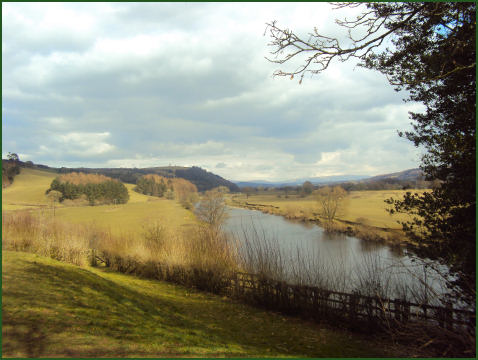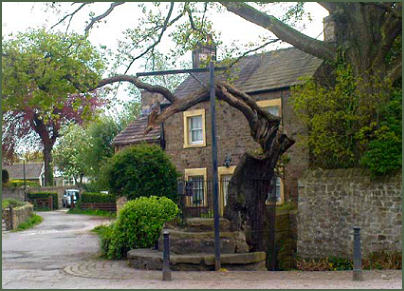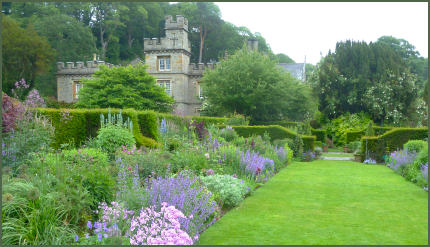Caton with Littledale
OS Grid ref:- SD532645
 The village of Caton with Littledale is situated 5 miles to the north east of Lancaster and lies in the Lower Lune Valley.
The village of Caton with Littledale is situated 5 miles to the north east of Lancaster and lies in the Lower Lune Valley.
The landscape ranges from hills and becks to the flat flood plain of the River Lune. The beauty of the area was captured by the artist J M W Turner and described by the poet William Wordsworth. When the art critic and philanthropist John Ruskin first saw the Lune Valley, he declared "I do not know in all my country, still less France or Italy, a place more naturally divine or a more priceless possession of the true Holy Land..."
Caton Moor lying to the east of the village rises to over 1,000 feet and to the south stands Clougha Pike at 1,355 feet and Ward's Stone, the highest hill in the Forest of Bowland.at 1,841 feet. The Artle Beck flows in a northerly direction towards the wider flatter valley of the River Lune.
The nearby Crook O’ Lune (pictured left) is a popular beauty spot, where the River Lune meanders in a large curve through tree-lined banks. The view along the Lune Valley is stunning, looking north east to the plateau of Ingleborough. A picnic site and car park are provided.
 The original settlement of Caton was renamed Brookhouse after Brookhouse Hall and is separated from modern Caton by Artle Beck. Evidence of the Roman occupation survives in the form of a mill stone, measuring eight feet long which was discovered in Artle Beck in 1803, it bears the name of the Emperor Hadrian. Irish-Norse invaders settled in the area in the tenth century and Caton derives its named from the Norse personal name Kati and ton.
The original settlement of Caton was renamed Brookhouse after Brookhouse Hall and is separated from modern Caton by Artle Beck. Evidence of the Roman occupation survives in the form of a mill stone, measuring eight feet long which was discovered in Artle Beck in 1803, it bears the name of the Emperor Hadrian. Irish-Norse invaders settled in the area in the tenth century and Caton derives its named from the Norse personal name Kati and ton.
An ancient gnarled oak tree, known as the Druid's Oak, or the Caton Oak, (pictured right) stands near the Ship Inn, the sandstone steps which surround it were known as the Fish Stones. The plaque by it reads:-
'The three semi-circular sandstone steps, shaded by the oak tree, were used in medieval times by the monks of Cockersand Abbey to display and sell fish caught from the River Lune. The ancient oak tree, reputed to date back to the time of the druids, and the Fish Stones, have become a landmark and Symbol of Caton.'
The tower of the village church of St. Paul at Brookhouse dates to the sixteenth century. The rest of the church was rebuilt in 1865–67 to a design by the Lancaster architect E. G. Paley.
A plague stone is set in the bridge over Bull Beck. Five mills were built at Town End in the late eighteenth century. Low Mill cotton mill dates from 1783, built by Thomas Hodgson (1738–1817), it occupies the site of a thirteenth century corn mill. It was powered by a millrace from the Artle Beck at Gresgarth.
Gresgarth Hall Garden
 Gresgarth Hall Garden near Caton has been owned by the Gold medal-winning landscape designer, Arabella Lennox-Boyd since 1978.
Gresgarth Hall Garden near Caton has been owned by the Gold medal-winning landscape designer, Arabella Lennox-Boyd since 1978.
The beautiful garden features terraces, lakes, a small bog garden, a wild garden, an extensive kitchen garden, a bluebell wood, the Millenium Wood, the Rhododendron Hills, the herbaceous borders and a serpentine walk.
The terraces descend from the hall to the lake, and are planted with roses, clementis and herbacous plants, the predominating colours of pink, shades of purple and silver whites compliment the grey stone of the Gothic style house.
The river, the fast flowing Artle Beck, runs through the property on its course to join the river Lune. A Chinese-style bridge crosses the beck and draws the visitors to view the sculptures, both classical and modern, which include a folly and tufa obelisk set amongst birch trees. The valley is planted on both sides with a collection of rare and interesting trees, some of them grown from seed collected in Japan.
Open on certain weekends in spring, summer and autumn. Usually the second Sunday of the month from Sunday 10 February 2013 until Sunday 10 November 2013. There are special open days at the begining and end of the season.
Directions
Exit the M6 at junction 34 and follow the A683 to Caton, turn right towards Quernmore and continue for around half a mile to reach the entrance.
Nearby Places of Interest
Lancaster Castle founded in the tenth century
Ashton Memorial in Williamson Park, Lancaster was commissioned by James Williamson, Baron Ashton as a tribute to his second wife, Jenny and was built between 1907 and 1909.
Butterfly House, Lancaster
Whalley Abbey- founded by Henry de Lacy, third Earl of Lincoln on the 4th April 1296.
Clitheroe Castle-Norman castle keep and museum, said to be one of the oldest buildings in Lancashire, and one of the smallest keeps in England,
